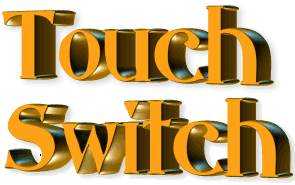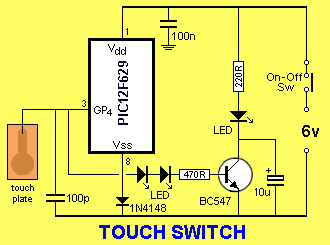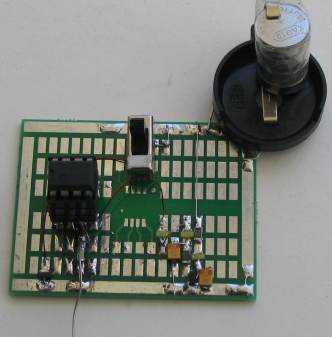Table Of Contents

[Kits are available](mailto:colin@elechelp.com?Subject=Buying kit for Touch Switch&Body=Please e-mail the cost of kit for Touch Switch on prototype PC board $15.00 + postage by air mail to my country:****___**** and send details of how I can pay for it. My name is:____) for this project from Talking Electronics for $15.00 plus postage.
See more projects using PIC micros:Elektor,EPE,Silicon Chip
”Pick-A-PIC.”
You can add this circuit to all sorts of projects that require on-off control.
Our design allows up to 4 touch sensors using a PIC12F629. The output of each touch sensor is active LOW and this can be connected to an additional circuit to control a LED, motor or relay etc.

The photo of the project shows one output with the two LEDs connected in series to produce an infinitely high input impedance so that one of the input/output lines of the micro can be used as both input and output. Two LEDs drive the base of a transistor and a third LED is connected to the collector of the transistor to indicate it is being activated.
The input lines to a PIC microcontroller contain FETs and a FET has an almost infinite input impedance (resistance). This mean it is very sensitive and will detect voltages that are called STATIC ELECTRICITY.

The Prototype PC board with one input
These voltages (Static Electricity and radiation from power cables and wiring) are all around the home and are produced by a number of things including the electromagnetic radiation from the 110v or 240v mains wiring, the radiation from a TV that uses a picture-tube (Cathode Ray Tube) by the electrons being fired by the gun towards the screen, the static produced when walking on carpet or produced by clothing hen it is moved on the body and the movement of paper and plastic items.
You will be amazed at where static electricity can be found and the input to the microcontroller we are using in this project will detect these charges, simply by connecting a wire to one of the input pins.
In fact the micro is so sensitive it will react uncontrollably when moved around the home.
The whole essence of this project has been to remove the uncontrollability-factor and create a touch wire that will only respond when it is touched.
This is a very difficult thing to do as we are using the very sensitive input of a pin to detect the charge (or lack of charge) produced by a finger and at the same time masking the charge from the surroundings.
The answer is to charge a small capacitor and see if the finger discharges it. This means the input will not be responsive to any static charges in the room.
For this to work, we are assuming the body is uncharged and some-times clothing etc will create a charged condition and the touch sensor will not work.
That’s why this project will not work in all situations and with all users.
However when it does work, it is amazing.
The slightest touch of the wire with a finger will turn on the LEDs.
You can build 1, 2, 3 or 4 sensors and use them with touch pads to control all types of devices.
One of the clever features of this circuit is the use of a single input/output line as both an input and output.
This is called multiplexing or “sharing.”
The line is firstly set up as an output and the 100p capacitor is charged. It is then turned into an input line and a 20mS delay is called to give a short period of time for a finger to discharge the capacitor.
The charge on the capacitor is then detected after this time and if it is low, the line is turned into an output to activate the base of the transistor via two LEDs.
These LEDs have been included to produce an infinitely high impedance on the line so that the charge on the 100p capacitor will not be affected.
The two LEDs and base-emitter junction of the transistor will produce an infinite impedance to voltages below the turn-on voltage of the combination.
Another clever circuit-design is placing a diode between the “ground” or Vss line of the micro and the 0v rail.
This reduces the 6v supply to 5.4v (as this is the maximum voltage the chip can be delivered). But more importantly it increases the sensitivity of the input line and makes the project much more sensitive by actually raising the zero-detection-point by about 0.5v.
INSTRUCTIONS FOR USE
Touch the Touch Plate or wire and allow the capacitor to discharge. The LED corresponding to the sensor will illuminate and the transistor will sink up to 100mA.
CONSTRUCTION
The circuit can be built on any type of Proto board. We have used one of our surface-mount PC boards as all the components and wiring can be seen at the same time and this makes construction and diagnosis easy.
The photo shows only one input however the board is big enough to add the three other sections.
The PROGRAM
This project is part of a course in PIC Programming Course.
The course consists of building these projects and modifying the programs to learn the art of programming PIC microcontrollers.
Here are the files you will need for “burning” your chip and/or modifying the program:
The following program is for viewing. It may contain spaces or hidden characters that will not compile correctly to produce a .hex file. Use the .hex file above to burn your chip or the .asm file to modify the program.
;*******************************
;**Touch Switch.asm**
;13-10-2010
;***********************
list p=12F629
radix dec
include "p12f629.inc"
errorlevel -302 ; Don't complain about BANK 1 Registers
__CONFIG _MCLRE_OFF & _CP_OFF
& _WDT_OFF & _INTRC_OSC_NOCLKOUT ;Internal osc.
;_MCLRE_OFF - master clear must be off for gp3 to be input pin
;****************************************************************
; variables - names and files
;****************************************************************
temp1 equ 20h ;
temp2 equ 21h ;
temp3 equ 22h ;
temp4 equ 23h ;
_flash equ 24h ;
;****************************************************************
;Equates
;****************************************************************
status equ 0x03
rp1 equ 0x06
rp0 equ 0x05
GPIO equ 0x05
status equ 03h option_reg equ 81h
; bits on GPIO
pin7 equ 0 ;GP0
pin6 equ 1 ;GP1
pin5 equ 2 ;GP2
pin4 equ 3 ;GP3
pin3 equ 4 ;GP4
pin2 equ 5 ;GP5
;bits
rp0 equ 5 ;bit 5 of the status register
;****************************************************************
;Beginning of program
;****************************************************************
org 0x00
nop
nop
nop
nop
nop
SetUp bsf status, rp0 ;Bank 1
movlw b'11101000' ;Set TRIS GP1,2,out GP5 in
movwf TRISIO ;
bcf status, rp0 ;bank 0
movlw 07h ;turn off Comparator ports
movwf CMCON ;must be placed in bank 0
call flash
clrf GPIO ;Clear GPIO of junk
goto Main
;****************************************************************
;* Delays *
;****************************************************************
_10us goto $+1
goto $+1
goto $+1
goto $+1
retlw 00
_250uS movlw .80
movwf temp1
decfsz temp1,f
goto $-1
retlw 00
_1mS nop
decfsz temp1,f
goto $-2
retlw 00
_10mS movlw .10
movwf temp2
_10 nop
decfsz temp1,f
goto _10
decfsz temp2,f
goto _10
retlw 00
_20mS movlw .20
movwf temp2
_20 nop
decfsz temp1,f
goto _20
decfsz temp2,f
goto _20
retlw 00
_250mS movlw .250
movwf temp2
_250 nop
decfsz temp1,f
goto _250
decfsz temp2,f
goto _250
retlw 00
;****************************************************************
;* Sub Routines *
;****************************************************************
;flash LED at start-up
flash movlw 0ffh
movwf _flash
bsf gpio,1
nop
decfsz _flash,1
goto $-2
bcf gpio,1
retlw 00
;****************************************************************
;* Main *
;****************************************************************
Main bcf gpio,4 ;make line LOW to discharge 100p
call _10uS
bsf gpio,4 ;make line HIGH to charge 100p
bsf status, rp0 ;Bank 1
movlw b'11111000' ;Set TRIS GP4 in
movwf TRISIO
bcf status, rp0 ;bank 0
call _20mS
btfss gpio,4
goto $+3
bcf gpio,2
goto Main
bsf status, rp0 ;Bank 1
movlw b'11001000' ;Set TRIS GP4 out
movwf TRISIO
bcf status, rp0 ;bank 0
bsf gpio,4 ;turn on LEDs and transistor
call _250mS
goto Main
END
GOING FURTHER
You can add additional features to this project by writing your own program or adding to the program above. Send any additions to Talking Electronics for inclusion in this article.
Touch Switch - Parts List
Cost: au$15.00 plus postage [Kits are available](mailto:colin@elechelp.com?Subject=Buying kit for Touch Switch&Body=Please e-mail the cost of kit for Touch Switch on prototype PC board $15.00 + postage by air mail to my country:****___**** and send details of how I can pay for it. My name is:____)
4 - 220R SM resistor
4 - 470R SM resistor
4 - 100p SM capacitors
1 - 100n SM capacitors
4 - 10u SM electrolytic
12 - SM yellow LEDs
1 - SM diode
4 - BC847 SM transistors
1 - SPDT mini slide switch
1 - 8 pin IC socket
1 - 20cm fine enamelled wire
1 - 10cm tinned copper wire for touch wires
1 - 20cm - very fine solder
1 - PIC12F629 chip (with Touch Sw routine)
1 - battery holder
4 - button cells
-1 - Prototype PC board
Quick Links
Legal Stuff
Social Media


